Best practices
Google Ads
Optimisation Checklist
Conducting a thorough Google Ads audit is the first step in identifying areas for improvement and optimizing your campaigns for better results.

Review Campaign Performance
Guideline
Implementation
Impact
Sort campaigns by highest spend to identify where your budget is being allocated. Analyze:
- CTR (Click-Through Rate): Measures ad engagement (clicks ÷ impressions)
- ROAS (Return on Ad Spend): Revenue generated per dollar spent (Conv. Value ÷ Cost)
- Revenue: Total conversion value from sales
- Number of Sales: Total conversions recorded
- CPA (Cost Per Acquisition): Cost to acquire one customer (Cost ÷ Conversions)
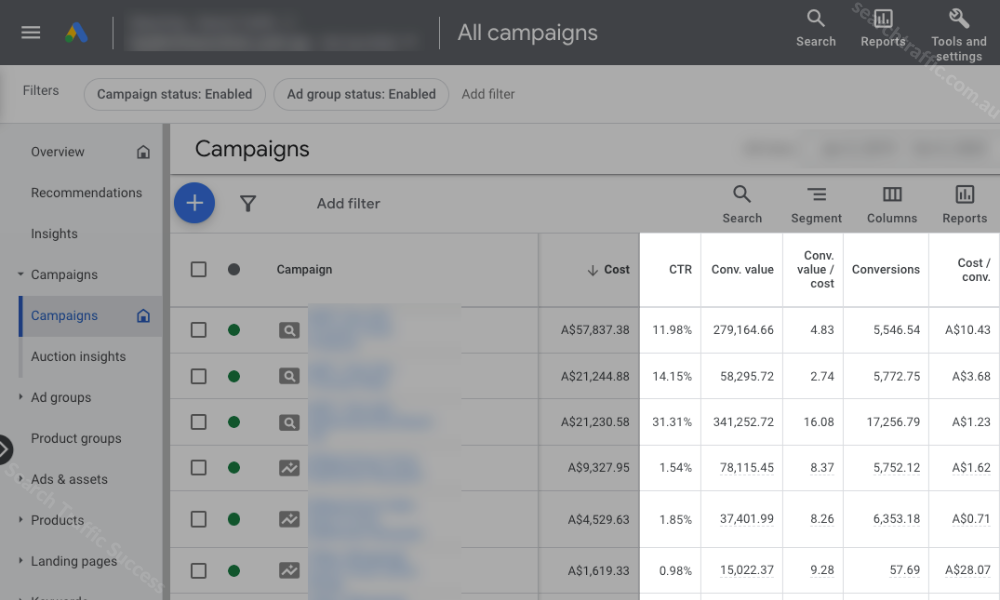
For eCommerce campaigns, focus on these key performance indicators:
- CTR: Aim for at least 2-3% for search campaigns. Low CTR may indicate poor ad relevance.
- ROAS: Calculate your break-even ROAS (1 ÷ profit margin) and aim for 2-3x that number.
- Revenue: Compare against historical performance and seasonality trends.
- Number of Sales: Ensure conversion tracking is accurate and recording all purchases.
- CPA: Compare against your target CPA based on customer lifetime value.
Use these metrics to identify underperforming campaigns that may need bid adjustments, ad copy updates, or budget reallocation.
For lead generation campaigns, prioritize these metrics:
- CTR: Indicates how compelling your ad is to your target audience.
- Leads: Total number of form submissions, calls, or other conversion actions.
- Cost Per Lead: Compare against your target cost based on lead quality and close rate.
Additional considerations:
- Review lead quality - high volume of low-quality leads may indicate targeting issues
- Check conversion paths - ensure forms are working and thank-you pages are tracking properly
- Analyze time-to-conversion - some leads may take days or weeks to convert
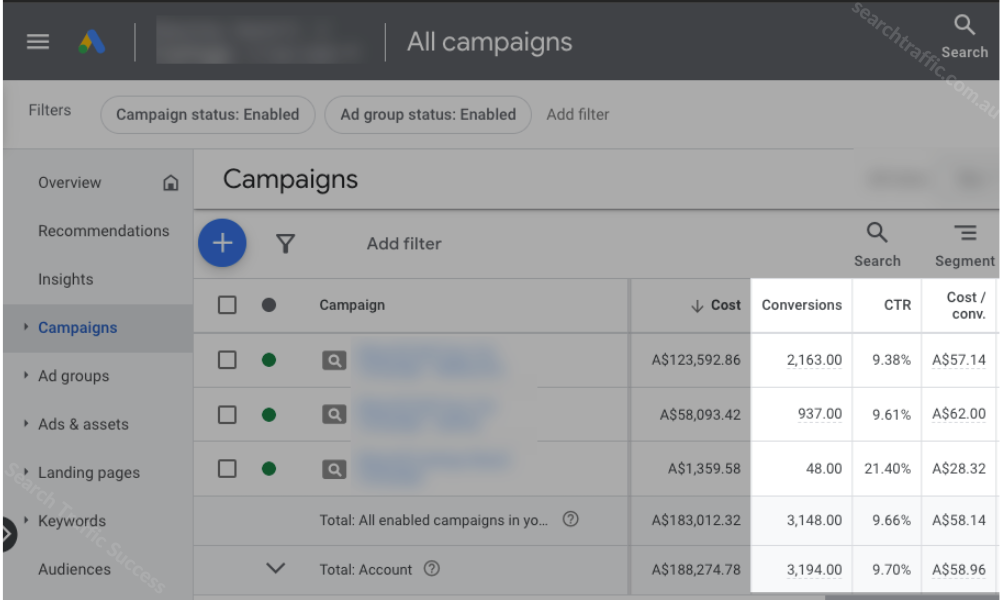

Review Ad Group Performance
Guideline
Implementation
Impact
Within each campaign, sort ad groups by cost to identify where budget is being spent:
For eCommerce:
- CTR: Should be comparable to campaign average
- ROAS: Identify ad groups generating the highest returns
- Revenue: Compare against historical performance
- CPA: Flag ad groups with CPA above target
For Lead Generation:
- Leads: Volume and quality of leads generated
- Cost Per Lead: Compare against target CPA

Take action on underperforming ad groups by adjusting bids, refining targeting, or improving ad copy.
The Auction Insights report shows how your ads perform against competitors:
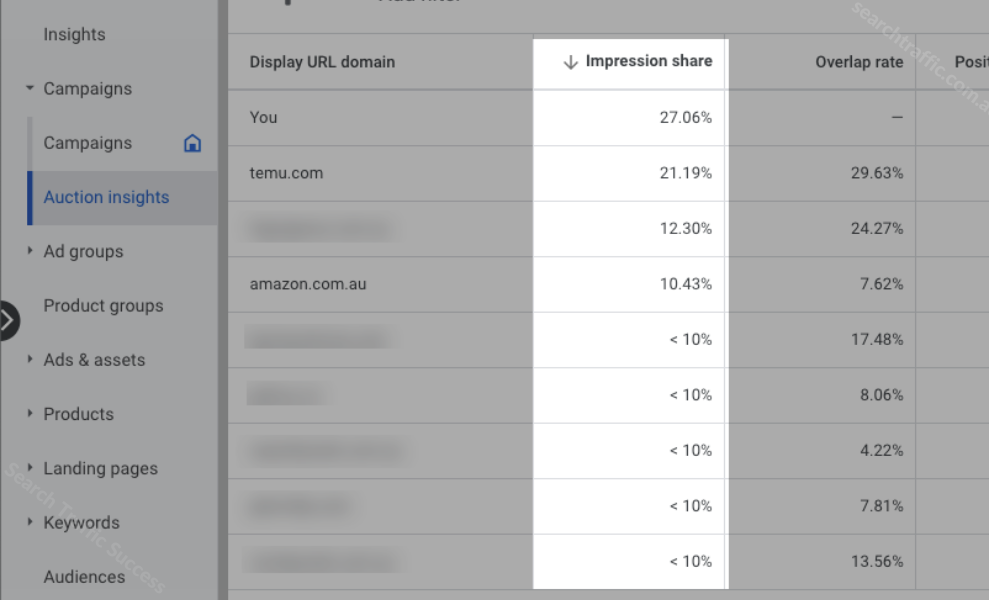
Key Metrics:
- Impression Share: Percentage of impressions you received vs. could have received. Low share may indicate budget constraints or low ad rank.
- Overlap Rate: How often your ad received an impression when a competitor's ad also appeared. High overlap indicates direct competition.
- Position Above Rate: How often competitors' ads ranked higher than yours.
- Top of Page Rate: Percentage of your impressions that appeared at the top of search results.
Use this data to:
- Identify main competitors in your space
- Adjust bids for highly competitive auctions
- Improve ad quality to increase impression share

Ads & Assets
Guideline
Implementation
Impact
Google's Ad Strength rating indicates how well your ad is optimized:
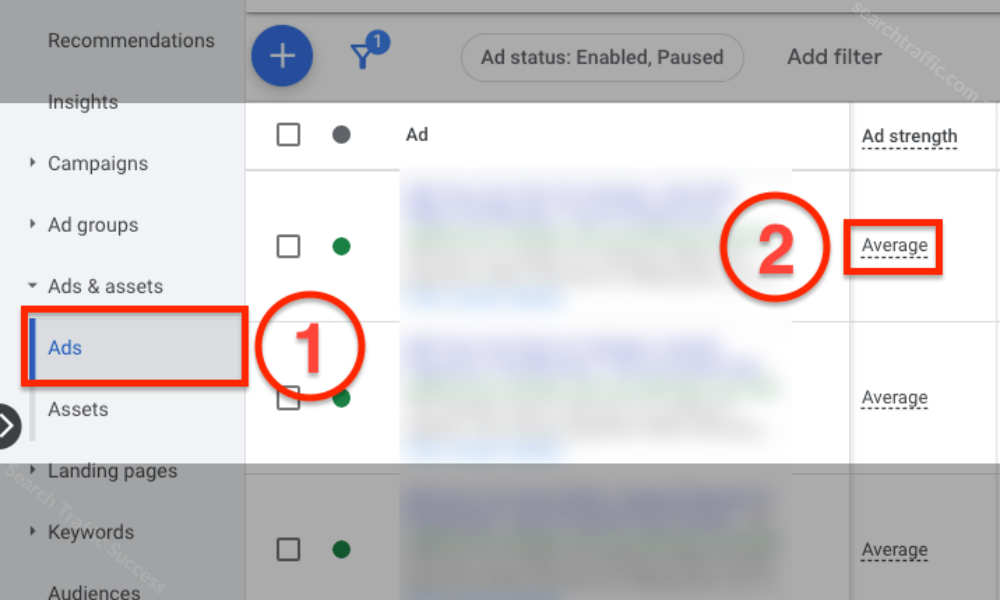
Steps to improve:
- Hover over the Ad Strength indicator
- Click "Improve Ad" for specific recommendations
- Update headlines to include more keywords
- Add more unique descriptions
- Ensure all assets are relevant to the ad group
- Pin important headlines to specific positions
Ad Strength affects your Quality Score and ad rank, so maintaining "Excellent" ratings can lower costs and improve visibility.
Effective headlines significantly impact CTR and Quality Score:

Best Practices:
- Include your main keyword in at least one headline
- Use all 30 characters when possible
- Create 3-5 unique headlines per ad group
- Highlight unique value propositions
- Include numbers or special offers when relevant
- Pin important headlines to position 1 or 2
Testing Ideas:
- Question vs statement headlines
- Price-focused vs benefit-focused
- Short vs descriptive headlines
Descriptions provide the details that convince users to click:
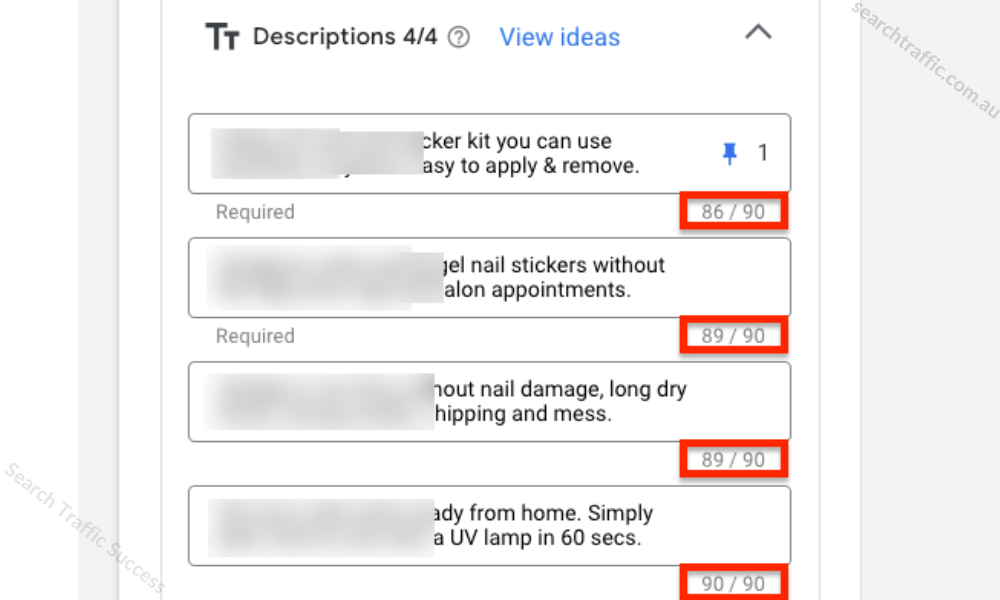
Optimization Tips:
- Include primary keyword once naturally
- Maximize the 90-character limit
- Focus on benefits rather than features
- Include a clear call-to-action (e.g., "Shop Now", "Get Quote")
- Highlight unique selling points
- Use sentence case for better readability
- Create 2-4 unique descriptions per ad group
Effective CTAs:
- Limited time: "Sale ends soon!"
- Value proposition: "Free shipping on all orders"
- Urgency: "Limited quantities available"
- Trust: "Rated 5-stars by customers"
Extensions make your ads larger and more informative:
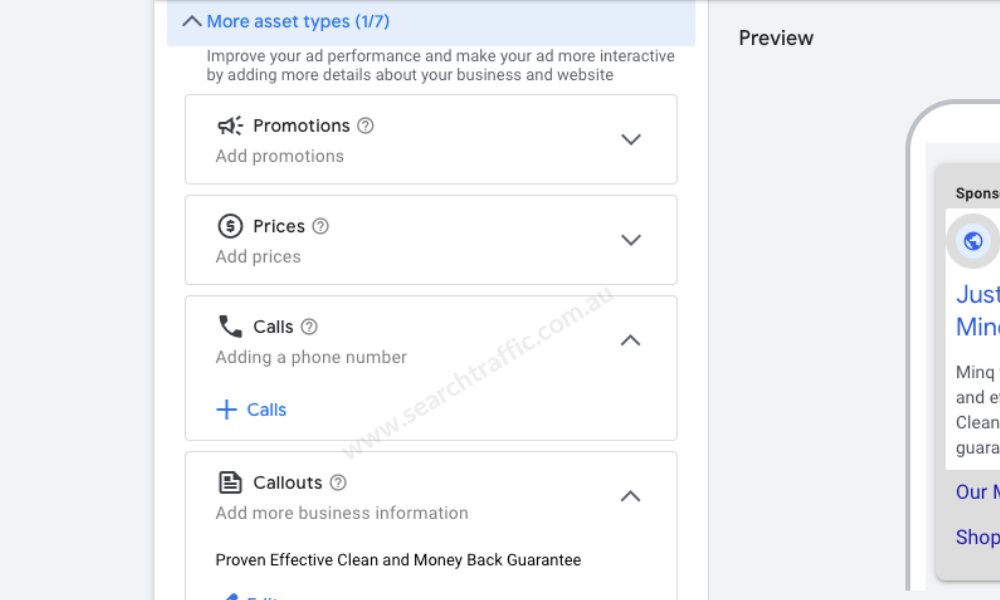
Key Extension Types:
- Sitelinks: Deep links to specific pages (4-6 per campaign)
- Callouts: Highlight benefits (e.g., "Free Shipping", "24/7 Support")
- Structured Snippets: Showcase product categories or services
- Call Extension: Phone number with click-to-call on mobile
- Message Extension: Allow users to text your business
- Price Extension: Display products with prices
- Promotion Extension: Highlight special offers
Best Practices:
- Use at least 4 extension types per campaign
- Update seasonally or for promotions
- Make extensions specific to each ad group
- Review extension performance monthly

Landing Page Optimization
Guideline
Implementation
Impact
Fast-loading pages improve user experience and Quality Score:
Tools to Use:
- Google PageSpeed Insights
- GTmetrix
- WebPageTest
Optimization Strategies:
- Compress images (aim for <100KB for hero images)
- Enable browser caching
- Minify CSS, JavaScript, and HTML
- Use a CDN (Content Delivery Network)
- Reduce server response time
- Lazy load below-the-fold images
- Remove unnecessary plugins or scripts
Target Metrics:
- Load time under 2 seconds
- PageSpeed score above 80/100
- Time to Interactive under 3 seconds
With most traffic coming from mobile, optimization is crucial:
Checklist:
- Use responsive design that adapts to all screen sizes
- Ensure buttons and CTAs are thumb-friendly (minimum 48x48px)
- Use legible font sizes (16px minimum for body text)
- Simplify forms with minimal fields
- Optimize images for mobile networks
- Avoid intrusive interstitials
- Test on multiple real devices (not just emulators)
Testing Tools:
- Google's Mobile-Friendly Test
- BrowserStack for cross-device testing
- Chrome DevTools device toolbar
Mobile-Specific Features:
- Click-to-call buttons for phone-based businesses
- Accelerated Mobile Pages (AMP) for content sites
- Location-based features for local businesses
Relevant landing pages improve Quality Score and conversion rates:
Alignment Checklist:
- Main keyword appears in H1 tag
- Ad copy matches headline on landing page
- Products/services shown match the ad
- Consistent messaging throughout the funnel
- Visual continuity (colors, branding)
Improvement Strategies:
- Create dedicated landing pages for top products/services
- Use dynamic keyword insertion for better relevance
- Group similar keywords into tightly themed ad groups
- Remove distracting navigation on conversion-focused pages
Signs of Poor Relevance:
- High bounce rate (>70%)
- Low time on page (<30 seconds)
- High exit rate on first pageview
- Low Quality Score (4 or below)
Clear CTAs guide users toward conversion:
Best Practices:
- Place primary CTA above the fold (visible without scrolling)
- Use action-oriented language ("Buy Now", "Get Quote", "Download")
- Make buttons stand out with contrasting colors
- Include secondary CTAs further down the page
- Use directional cues (arrows, eye gaze in images)
- Keep form fields to a minimum
Effective CTA Examples:
- "Start Your Free Trial"
- "Get Instant Quote"
- "Shop the Collection"
- "Book Your Appointment"
- "Download the Guide"
Testing Ideas:
- Button color (green vs red vs blue)
- Button text (Buy vs Purchase vs Order)
- Button placement (left vs right vs center)
- Button size (normal vs large)
Trust elements reduce hesitation and increase conversions:
Types of Trust Signals:
- Testimonials: Real customer quotes with names/photos
- Reviews: Display star ratings from Google, Trustpilot, etc.
- Security Badges: SSL certificates, payment security logos
- Social Proof: "X customers served" counters
- Media Mentions: "As seen in" logos
- Guarantees: Money-back, satisfaction, or price-match promises
- Certifications: Industry awards or accreditations
Placement Tips:
- Near pricing information
- Beside form submission buttons
- In the header/footer for site-wide credibility
- On checkout pages to reduce cart abandonment

Review Keywords & Quality Score
Guideline
Implementation
Impact
Proper keyword organization improves relevance and Quality Score:
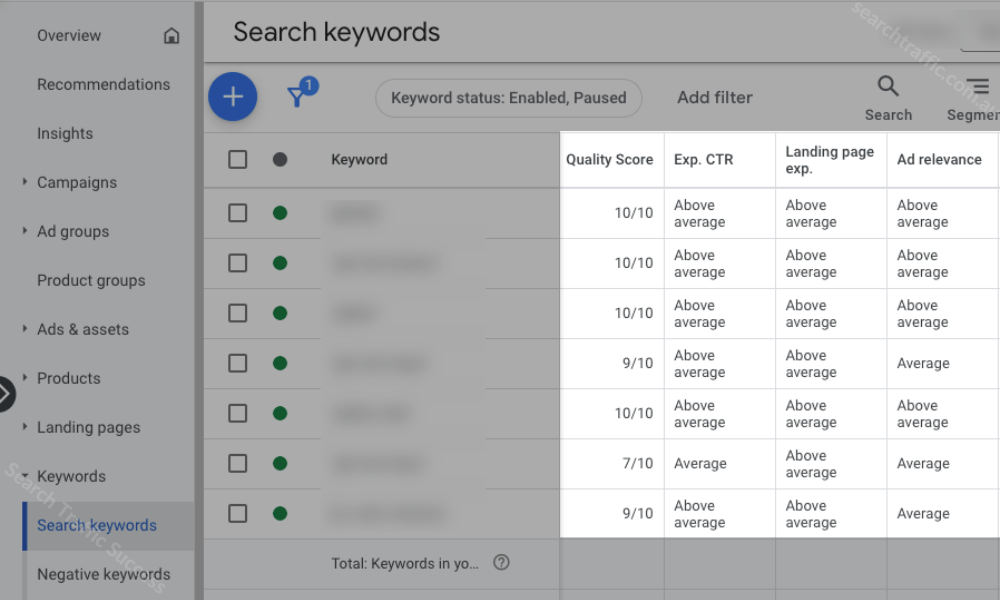
Best Practices:
- Group keywords by intent (commercial, informational, navigational)
- Create tightly themed ad groups (5-20 similar keywords)
-
Use match types strategically:
- Exact: [keyword] - high intent, precise control
- Phrase: "keyword" - moderate reach with control
- Broad Match Modified: +keyword +variations - wider reach
- Avoid broad match only for branded or high-value terms
- Regularly prune underperforming keywords
Negative Keywords:
- Add irrelevant search terms as negatives
- Review search term reports weekly
- Create shared negative keyword lists for efficiency
Quality Score (1-10) affects ad position and cost-per-click:
Components:
- Expected CTR: Improve with better ad copy and targeting
- Ad Relevance: Ensure ads match keyword intent
- Landing Page Experience: Optimize page speed, relevance, and usability
Improvement Strategies:
- For scores 1-4: Consider pausing or completely revising
- For scores 5-7: Incremental improvements to ad copy and landing pages
- For scores 8-10: Maintain and test small optimizations
- Segment by keyword to identify problem areas
- Compare Quality Score to conversion rates - sometimes lower QS keywords convert well
Impact of Quality Score:
- Higher scores can lower CPC by up to 50%
- Improves ad position at the same bid
- Increases impression share for limited budgets
The search terms report reveals what queries actually triggered your ads:
How to Use:
- Navigate to Keywords > Search terms
- Set appropriate date range (last 30-90 days)
- Sort by cost to identify expensive, irrelevant terms
- Filter for conversions = 0 to find wasteful spend
- Add negative keywords for irrelevant searches
- Add new keywords for relevant, high-performing searches
Negative Keyword Strategies:
- Brand Protection: Add competitor names if you don't want to appear for them
- Qualifiers: Add "free" if you don't offer free products
- Misaligned Intent: Add "jobs" if you're not hiring
- Irrelevant Categories: Add product types you don't sell
Frequency: Review search terms at least weekly for new campaigns, monthly for established ones.

Review Budgets
Guideline
Implementation
Impact
Proper budget allocation maximizes ROI:
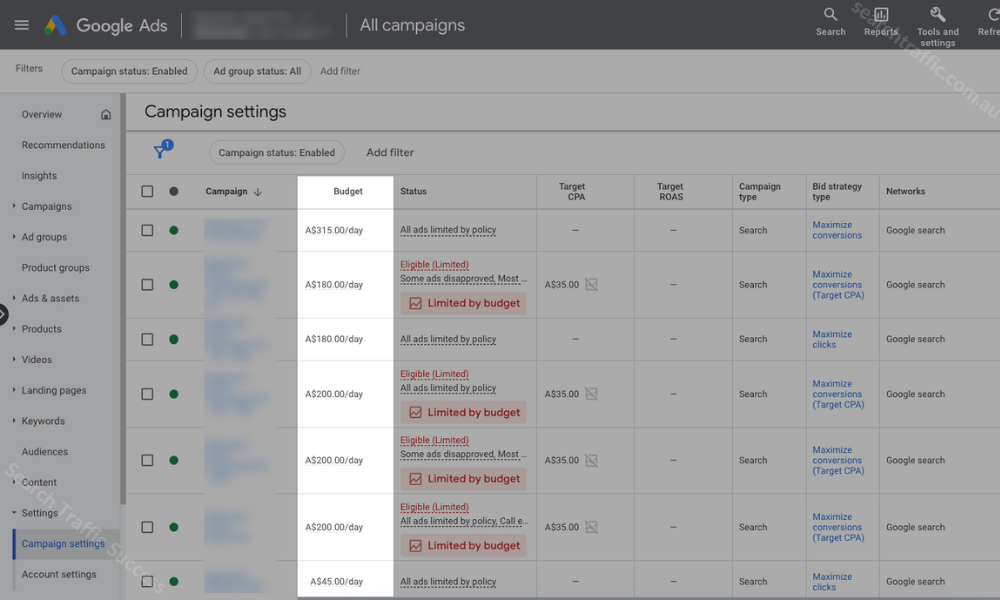
Budget Review Process:
- Navigate to Campaigns view
- Sort by cost or conversions
- Identify campaigns hitting budget limits (look for "Limited by budget")
- Check campaign delivery (spend pace throughout the day/month)
-
Adjust budgets based on performance:
- Increase for high-ROAS campaigns
- Decrease or pause underperformers
Bid Strategy Recommendations:
- eCommerce: Maximize conversion value (optimizes for revenue)
- Lead Gen: Maximize conversions (optimizes for lead volume)
- New Campaigns: Maximize clicks (builds initial data)
- Brand Awareness: Target impression share
Set appropriate target ROAS or CPA based on historical performance.

Locations
Guideline
Implementation
Impact
Targeting the right locations improves campaign efficiency:
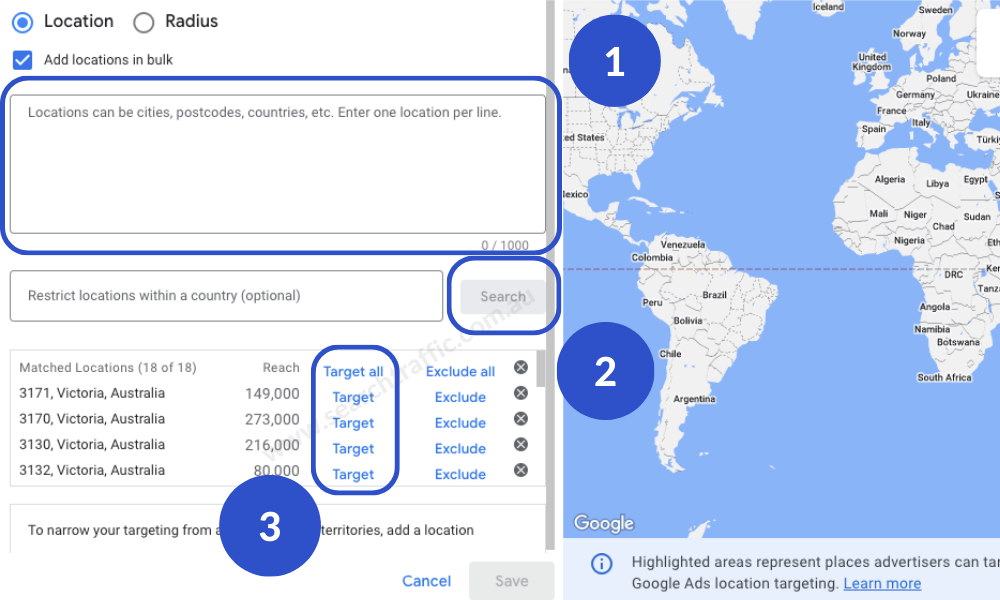
Location Types:
- Countries: For nationwide or international campaigns
- Regions/Cities: For businesses with specific service areas
- Radius: For local businesses (e.g., 10 miles around your store)
- Location Groups: Combine multiple locations into one target
Best Practices:
- Set location options to "Presence" (not interest) for precise targeting
- Exclude areas where you don't do business
- Create separate campaigns for different regions if performance varies
- Adjust bids by location for better ROI
- Use location assets for local businesses
Analyze performance by location to optimize targeting:
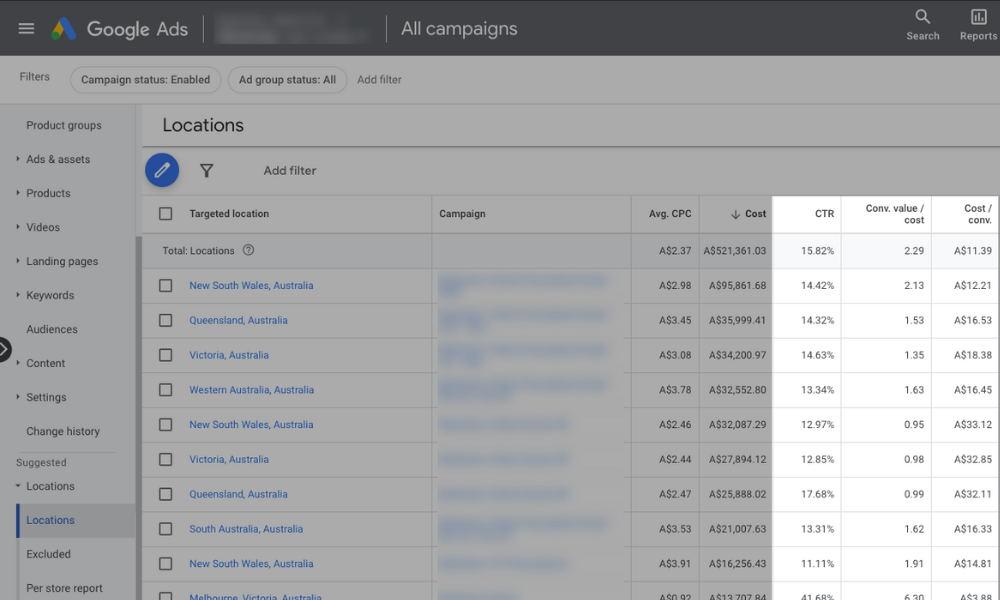
Key Metrics by Location:
- CTR: Indicates ad relevance to local audiences
- Conversion Rate: Shows where users are most likely to convert
- ROAS/CPA: Reveals most profitable locations
- Impression Share: Shows untapped potential in certain areas
Optimization Actions:
- Increase bids for high-performing locations
- Decrease bids or exclude underperforming areas
- Create location-specific ad copy for better relevance
- Adjust budgets based on regional performance
- Test different radius sizes for local businesses
Review location performance at least quarterly, or monthly for large campaigns.

Review Performance by Audiences
Guideline
Implementation
Impact
Demographic data reveals which groups respond best to your ads:

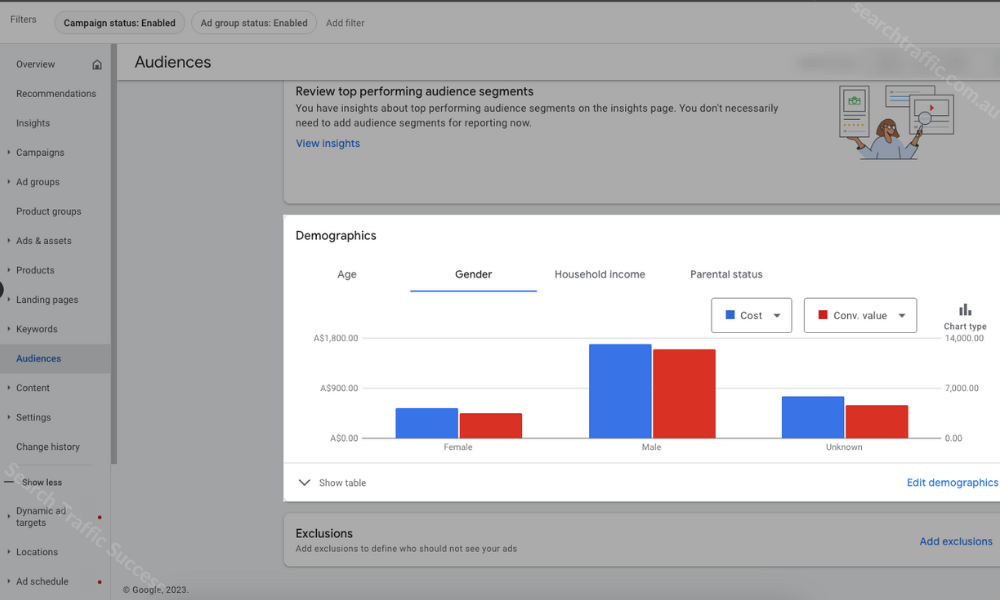
How to Analyze:
- Navigate to Audiences > Demographics
- Review performance by age group and gender
- Compare metrics like CTR, conversion rate, and CPA
- Identify underperforming segments
Optimization Strategies:
- Increase bids for high-converting demographics
- Decrease bids or exclude poorly performing groups
- Create tailored ad copy for different age groups
- Adjust imagery to better appeal to target demographics
- Consider separate campaigns for significantly different audiences
Note: Some demographic data may be limited due to user privacy settings.

Review Performance by Devices
Guideline
Implementation
Impact
Device performance analysis helps optimize bids and landing pages:

Key Metrics by Device:
- Mobile: Typically higher CTR but lower conversion rates
- Desktop: Often lower CTR but higher conversion rates
- Tablet: Performance usually falls between mobile and desktop
Optimization Strategies:
-
Adjust device bid modifiers based on performance:
- Increase for devices with high conversion rates
- Decrease for devices with poor ROI
- Ensure landing pages are fully optimized for each device type
- Create device-specific ad extensions (e.g., click-to-call for mobile)
- Test different ad copy emphasizing mobile-friendly features
Note: Device bid adjustments range from -100% to +300%.

Review Conversion Tracking
Guideline
Implementation
Impact
Proper conversion tracking is essential for optimization:
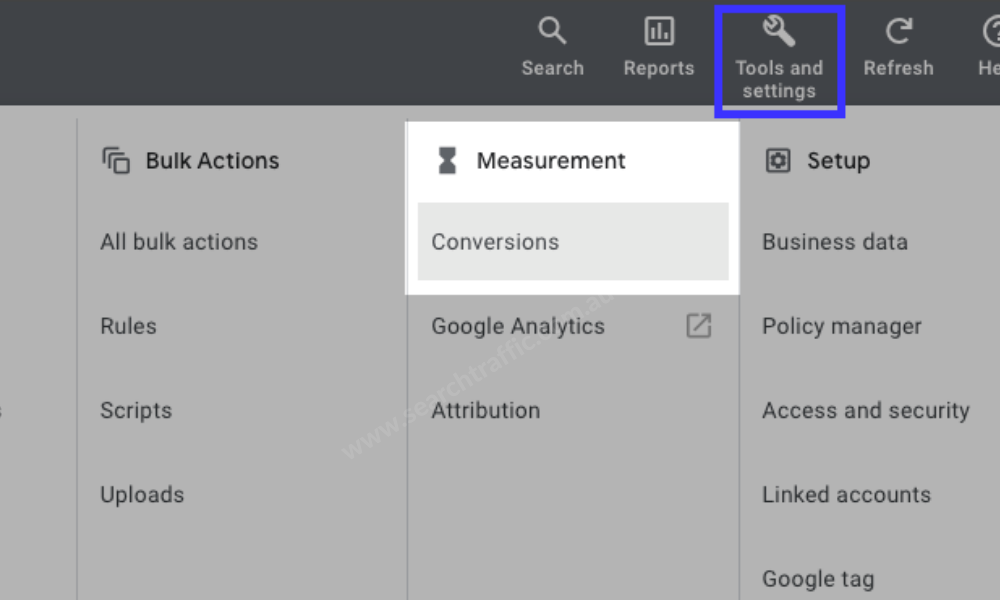
Common Conversion Types:
- Website Purchases: Track completed transactions
- Lead Form Submissions: Record contact requests
- Phone Calls: Track calls from ads or website
- App Downloads: Measure installs from app campaigns
- Sign-ups: Monitor account creations
- Page Views: Track visits to key pages (e.g., thank you pages)
Setup Verification:
- Navigate to Tools & Settings > Conversions
- Check that all relevant conversion actions are present
- Verify each conversion is assigned to the correct campaign
- Confirm conversion values are set properly (especially for eCommerce)
- Test conversion tracking by completing test conversions
Update conversion goals whenever business objectives or website structure changes.
Accurate tracking code ensures reliable data:
Verification Steps:
- Check that the global site tag (gtag.js) is installed on all pages
- Verify event snippets are placed on conversion pages
- Use Google Tag Assistant to test implementation
- Check for duplicate tags that may double-count conversions
- Ensure tags fire after the conversion is complete (not during page load)
Common Issues:
- Tags removed during website updates
- Incorrect placement on dynamic pages
- Conflicts with other tracking scripts
- Missing tags on new pages
- Incorrect conversion values being passed
Testing Methods:
- Complete test conversions and verify they appear in Google Ads
- Use Google Analytics to cross-check conversion data
- Check for discrepancies between Google Ads and backend systems
Attribution models determine how conversion credit is assigned:
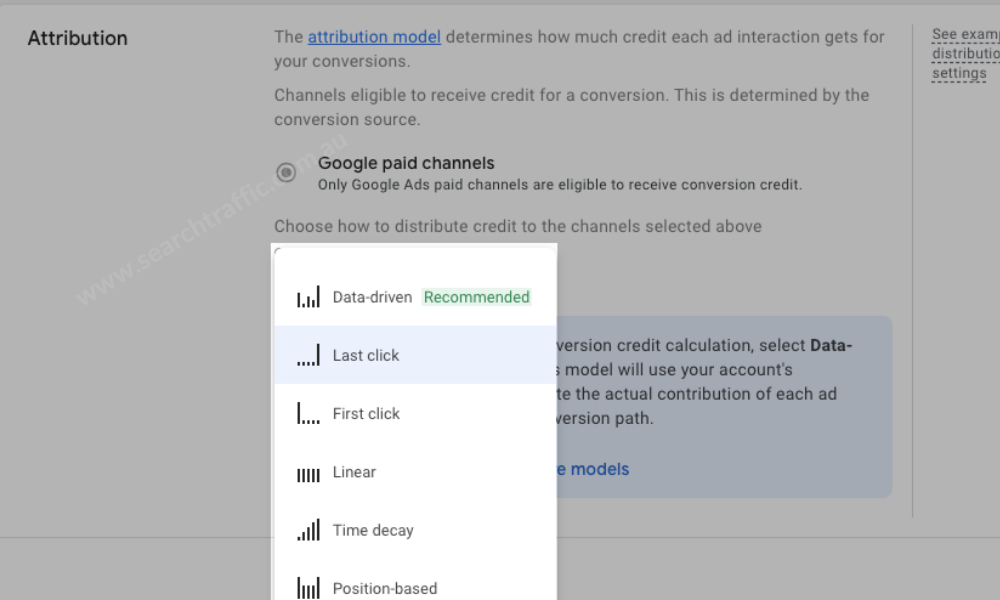
Model Types:
- Last Click: 100% credit to last ad clicked
- First Click: 100% credit to first ad clicked
- Linear: Equal credit to all touchpoints
- Time Decay: More credit to clicks closer to conversion
- Position Based: 40% first click, 40% last click, 20% others
- Data-Driven: Uses your account data to assign credit
Selection Guidelines:
- Use last-click for simple, direct-response campaigns
- Choose time decay or position-based for longer consideration cycles
- Use data-driven if you have sufficient conversion volume
- Compare models to understand full conversion paths
Review and adjust attribution models annually or when conversion paths change significantly.

Consider Ad Testing
Guideline
Implementation
Impact
Continuous testing improves ad performance over time:
Testing Methods:
- A/B Tests: Compare two distinct ad variations
- Multivariate Tests: Test multiple elements simultaneously
- Ad Rotation: Set to "Rotate indefinitely" for even delivery
Elements to Test:
- Headlines (different value propositions)
- Descriptions (benefits vs features)
- Display paths (URL structures)
- CTAs (action-oriented vs benefit-focused)
- Extensions (different combinations)
Best Practices:
- Test one variable at a time for clear results
- Run tests until statistical significance is reached
- Document test results and learnings
- Implement winning variations and iterate
- Test seasonally or when performance declines
Use Google's Drafts & Experiments feature for proper split testing.

We’re based in
Melbourne, Australia
 Audiences
Audiences